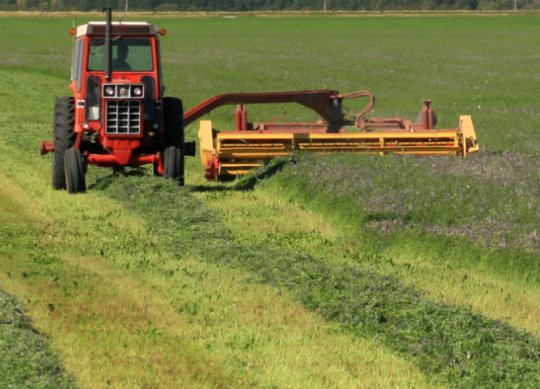Spring Alfalfa Harvest
Good quality forage is essential for profitable milk production. The most important factor affecting alfalfa quality is maturity at harvest. As alfalfa matures, digestibility decreases and fiber (NDF) content increases. Harvesting at the optimal maturity can be a challenge especially for first cutting when spring weather is not cooperative. Harvesting late affects the feeding value of alfalfa, but harvesting too early can result in lower yields and reduced stand life.
What is the correct harvest window for optimum alfalfa quality? The old 40-20 rule is often cited as the standard for alfalfa, i.e., 40% NDF and 20% crude protein (DM basis), as this optimizes profitability from a combination of factors including yield of alfalfa, supplement cost, and milk production potential. However, some producers might want to shoot for lower NDF (which usually is accompanied by higher CP) if other forages in the diet are higher in NDF and lower in protein (grasses).
There are a couple of methods that can be used to help better predict the best harvest time rather than relying on calendar date. Cumulative temperature during spring growth can vary widely from year to year resulting in very different forage quality (and maturity) on the same date. Accumulated growing degree days (GDD) can be used to predict spring alfalfa quality. Other methods include scissors cut (send in fresh samples to the lab for analysis), harvesting by stage of maturity (e.g. late bud), or by using PEAQ (Predictive Equations for Alfalfa Quality) which combines stage of maturity with height.
Growing Degree Days
Growing degree days (GDD) are a temperature related index related to the amount of heat that plants are exposed to, which is directly related to the rate of growth and maturity. Alfalfa GDD are calculated by averaging the minimum and maximum temperature for a given day then subtracting the base temperature of 410 F to get the number of GDD for that day. (Note the base temperature is lower for alfalfa than for corn which is 500 F) If the average temperature for a given day is less than 410F, there are 0 GDD for that day.
Agricultural meteorology staff at Michigan State generate a table of GDD for alfalfa (linked below and updated on Tuesday and Thursday) March 1st through mid-June using data from weather stations throughout the state. www.agweather.geo.msu.edu
Alfalfa GDD can predict NDF content within 3% units about 70% of the time. Alfalfa is predicted to contain 38% NDF at 680 GDD. For the 2022 growing season, dates when 680 GDD was reached are listed for selected weather stations. It takes about an extra 290 GDD to reach a 45% NDF content. For the stations listed in table 1 it took about 10-14 days to go from 680 to 970 GDD. This means that alfalfa is gaining NDF content by 0.5 – 0.7% units/day beyond 680 GDD.
Table 1: 2022 Dates for reaching of 680 and 970 GDD by weather station
| Region | Station | County | 680 GDD | 970 GDD |
| SW | Allegan | Allegan | 23-May | 4-Jun |
| C | Ithaca | Gratiot | 26-May | 7-Jun |
| SE | Hudson | Lenawee | 26-May | 5-Jun |
| W | Fremont | Newaygo | 29-May | 12-Jun |
| Thumb | Pigeon | Huron | 30-May | 11-Jun |
| N | McBain | Missaukee | 3-Jun | 17-Jun |
This article was written on March 30, 2023, and it seems that the 2023 growing season is off to a late start and comparable to 2018 (see table 2).
Table 2. Six-year comparison of growing degree days in the month of March in Allegan, MI
| Year | Degree Days Base 41oF |
| 2023 | 11 |
| 2022 | 77 |
| 2021 | 135 |
| 2020 | 66 |
| 2019 | 36 |
| 2018 | 14 |
| Average | 57 |
Predictive Equations for Alfalfa Quality
The predictive equations for alfalfa quality (PEAQ) procedure estimates NDF content of a standing crop based on maturity and stem length from several locations in an alfalfa field. This is an easy method, it takes little time to perform, and has been shown as good at predicting NDF content at first harvest and even better at predicting NDF content for second harvest than GDD based prediction in 3 years of on-farm comparisons in several locations in Michigan. More details and how to execute this procedure can be found here.
Harvesting Considerations for New Seeding Alfalfa
To establish and maintain a new seeding successfully it is important for the plants to have a high level of energy reserves to survive the following winter. Vigorous plants with a well-developed root system can be harvested at bud or early bloom. If plants are small and poorly developed it is best to wait until mid-bloom before harvesting.
Summary
Based on the month of March, the 2023 growing season is off to a cold start and alfalfa GDD is the lowest in the last six years. Although one thing is for sure; GDD will increase through April, May, and early June. As field work like corn planting starts, don’t forget to keep an eye on alfalfa fields. Use GDD to approximate harvest timing and include plant maturity and height measurements with the PEAQ procedure to confirm and further refine harvest timing. If the goal is to harvest high quality forage, you are better off harvesting early in the ideal harvest window versus harvesting late.
Sources:
Timing Spring Alfalfa Harvest. Allen, M, L. Leep, and J. Anderson. Michigan State U. Forage Connection.
Harvest Management of Alfalfa. 2023. Penn State Extension
Map of weather stations. https://legacy.enviroweather.msu.edu/homeMap.php
Alfalfa Cutting Model. https://enviroweather.msu.edu/crops/alfalfa/alfalfacutting
Growing Degree Days comparison for the last 6 years. https://legacy.enviroweather.msu.edu/run.php?stn=alg&mod=w_ady&da1=1&mo1=3&da2=28&mo2=3&yr=2023&mc=539&ds=cd



